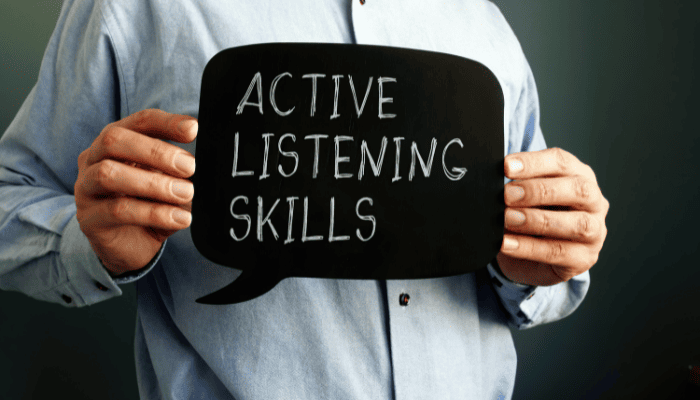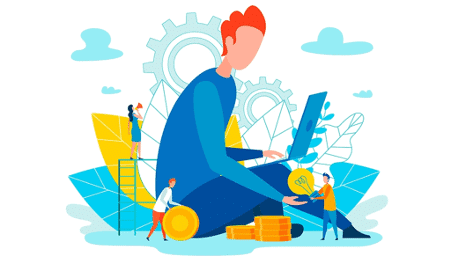The term “workplace wellness” describes the policies, plans, and endeavors businesses carry out to enhance their workforce’s general health, happiness, and standard of living. These efforts aim to foster a more supportive and efficient workplace environment while assisting staff members in preserving their mental, emotional, and physical well-being. Programs for workplace wellness might include a broad range of techniques and actions targeted at enhancing different aspects of well-being.
Also Read: Workplace Well-being Questionnaire: Best Practices & Questions
Why is Employee Well-Being Important?
 The overall well-being of employees is a crucial factor in shaping organizational health. It extends beyond individual feelings, impacting variables such as the frequency of sick leave, job performance, and employee retention. A decline in staff well-being directly correlates with a negative impact on your company’s bottom line.
The overall well-being of employees is a crucial factor in shaping organizational health. It extends beyond individual feelings, impacting variables such as the frequency of sick leave, job performance, and employee retention. A decline in staff well-being directly correlates with a negative impact on your company’s bottom line.
Let’s look at how employee wellbeing impacts the organization:
-
Improves Engagement
Employee engagement and heightened productivity thrive in an environment where employees experience good physical, mental, and emotional health. Their ability to deliver optimal performance is enhanced by the support and value they perceive from their employers. Highly engaged business units collectively contribute to a remarkable 23% boost in profitability.
Conversely, health issues or burnout often lead to employee disengagement, resulting in reduced production, increased absenteeism, turnover, and elevated medical expenses. Gallup’s research indicates that 75% of employee medical costs stem from preventable conditions, emphasizing the importance of proactive measures.
Also Read: Best Employee Engagement Strategies for Better Workplace
-
Reduces Healthcare Costs
Many organizations are concerned about rising employee healthcare costs since they can significantly affect their bottom line. Employers can encourage healthy lifestyle choices among their staff to lower the risk of chronic illnesses and improve the management of pre-existing medical conditions by implementing a comprehensive corporate wellness program. Such wellness programs offer a lucrative return on investment and can save your company big bucks in the long run.
-
Creates a Positive Organizational Culture
By demonstrating concern for the emotional and physical well-being of employees, organizations can promote a positive organizational culture. This fosters mutual support, trust, and a sense of belonging. Employee motivation and sense of worth are enhanced in such a setting, which fosters better teamwork and engagement.
Prioritizing well-being creates a culture that values open communication, lowers stress levels, and creates a sense of shared ownership over the company’s success.
-
Improves Employee Retention
Businesses that strongly focus on employee welfare have a higher chance of keeping their top employees than businesses that do not. Welfare initiatives lower employee turnover rates and the expenses of hiring and training new staff.
Work-life balance initiatives that support mental and physical well-being give employees the tools to successfully manage their personal and professional lives. Employees are more inclined to stick with the company because of the reduced risk of burnout and improved overall work experience.
-
Increases Job Satisfaction
Focus on employee well-being helps create a heightened sense of morale and workplace satisfaction by creating a caring work environment. Workers who feel encouraged to care for their physical and emotional well-being are less likely to burn out than those who do not. This favorably impacts their attitude toward work, boosting loyalty and commitment towards their work.
-
Enhances Innovation and Creativity
Workers in good physical and mental health will likely use creativity and innovation in their decision-making and problem-solving processes. This can help the organization stay ahead in a competitive marketplace.
-
Fosters a Sense of Unity
Certain workplace wellness initiatives allow workers to engage in non-work related activities, such as joining a sports team or having lunch with coworkers. Such engagement sessions promote camaraderie, which enhances team performance.
Employee Well-Being Initiatives Examples
-
Work from Home
Remote work enables workers to maintain a healthy work-life balance. Higher job satisfaction is frequently correlated with remote work’s enhanced autonomy. Workers are free to take as many or as few short breaks as they like, which helps them refuel and stay more energized.
-
Physical Activities
Employees who spend most of their time sitting at a desk require frequent breaks to stretch or move around. Organizations can prevent employee burnout by allowing and encouraging these short breaks.
Some businesses offer fitness classes and on-site gyms to encourage their staff to stay in shape. Some even provide their employees with paid memberships to sports fields, swimming pools, and fitness centers.
-
Healthy Meal Options
Fostering employee well-being through the provision of healthy meal options is a proactive and impactful strategy. By offering nutritious food choices, employers not only contribute to the physical health of their workforce but also create a positive and supportive work environment.
Healthy meal options can enhance overall employee health by providing essential nutrients that contribute to sustained energy levels and improved concentration. This, in turn, positively influences productivity and job performance. Additionally, promoting healthy eating habits can help prevent and manage chronic health conditions, reducing absenteeism and healthcare costs for both employees and employers.
-
Financial Literacy
Financial stress is a common challenge that working individuals face, creating a heavy burden that extends into all aspects of life, notably impacting work engagement.
When employees grapple with financial concerns, it often translates into disengagement from work and a compromised focus on well-being. A proactive solution is to provide your staff with financial education encompassing debt management, financial planning, and investment options. Empowering them with knowledge in these areas not only alleviates some of the stress associated with financial challenges but also equips them with tools to navigate their financial landscape more effectively. This, in turn, promotes a healthier work environment, fostering greater employee engagement and overall well-being.
-
Collaborative Work Environments
There are various ways in which collaborative workspaces can improve the well-being and engagement of your workforce.
Working close to other people has been shown to increase creativity and decision making. Allow your employees to work in a common area rather than in separate offices or cubicles. This way, communication and teamwork become easier.
Providing a respite from the routine is like a breath of fresh air for your employees. It promotes creative ideas and an alternative way of thinking. It also enhances cooperation between coworkers.
-
Modes of Transportation
Easy and hassle-free transportation options, such as shuttle services and cabs, can reduce stress levels associated with commuting. Organizations can ensure easy commutes by providing free travel cards/vouchers (Metro cards or Uber discounts/reimbursements). Another good idea is ensuring the physical workplace is accessible by common travel modes. This initiative also lowers the carbon footprint.
-
Counseling Services
Promoting mental health by providing counseling services is a proactive strategy. It may help employees deal with stress, anxiety, and personal issues by providing access to licensed counselors and therapists.
This program not only addresses the immediate concerns but also plays a crucial role in reducing the stigma surrounding mental health within the workplace. By fostering an atmosphere of acceptance and attentive listening, it contributes to an environment where employees feel supported.
-
Recognize and Reward
Recognizing well-performing employees is always a good idea. This will increase their sense of confidence and make them feel appreciated. It can go a long way in promoting employee well-being.
You can reward your top employees by handing out badges or certificates. You can also show appreciation during team meetings or through personalized notes to boost their motivation.
Summing Up
Prioritizing employee wellness is integral to the strategic success of any business. Comprehensive wellness initiatives, encompassing physical, mental, and emotional well-being, directly impact engagement, productivity, and organizational culture. Investing in employee wellness not only enhances individual job satisfaction but also contributes to increased efficiency, creativity, and talent retention.
A positive work environment that values well-being fosters collaboration and teamwork. Financially, a proactive approach to health can lead to substantial cost savings through reduced absenteeism and healthcare expenses. In essence, employee wellness is a strategic commitment that pays off in the form of a satisfied, engaged, and resilient workforce, positioning the organization for long-term success in a competitive business landscape.
Frequently Asked Questions
-
How can HR leaders promote mental health in the workplace?
HR leaders can promote mental health in the workplace by leading discussions on various mental health issues. It fosters a culture of open dialogue about workplace struggles and how to overcome them. They can also do so by offering employees ‘mental health days.’ These entail taking time out of their hectic schedules to relax, go out, and do whatever helps them rejuvenate.
-
How do you prioritize different wellness initiatives in the workplace?
Different programs can work differently for different organizations. Prioritizing wellness programs in the workplace requires a planned approach for maximum impact. To determine what’s most important for your company, you can zero in on the concerns of employees through surveys or focus groups. Then, address these concerns through wellness programs, like poor work-life balance or consistently working after work hours.
-
How do employee wellness programs lead to reduced absenteeism?
Workplace wellness programs reduce absenteeism by promoting work-life balance, healthy lifestyles, and mental well-being. These efforts decrease employee sick days, boost engagement, and create a healthy workplace. This leads to improved well-being and attendance.



 Create LGBTQ+-Specific Policies
Create LGBTQ+-Specific Policies

 More companies are seeking ways to sustain DEI in their workspaces, and for good reasons. From diversity in the recruiting process to manifesting gender pronouns, there are numerous ways to implement DEI strategies into your business practices. Here, we have listed six effective ways to help you create a DEI-safe workplace environment.
More companies are seeking ways to sustain DEI in their workspaces, and for good reasons. From diversity in the recruiting process to manifesting gender pronouns, there are numerous ways to implement DEI strategies into your business practices. Here, we have listed six effective ways to help you create a DEI-safe workplace environment.

 Studies show that a diverse workforce often performs better than their less diverse counterparts. A Gartner report suggests that nearly
Studies show that a diverse workforce often performs better than their less diverse counterparts. A Gartner report suggests that nearly 

 Burnout is a significant issue in the
Burnout is a significant issue in the 
 To set meaningful DEI metrics, organizations should follow these key steps:
To set meaningful DEI metrics, organizations should follow these key steps:
 According to a survey undertaken by the Australian economist Conrad Liveris, there are more CEOs named Andrew than female CEOs. In other words, there were more men than women with the same first name leading Australia’s 200 largest companies.
According to a survey undertaken by the Australian economist Conrad Liveris, there are more CEOs named Andrew than female CEOs. In other words, there were more men than women with the same first name leading Australia’s 200 largest companies.

 Employee engagement encompasses both the mental and professional dedication employees have towards their work, teams, and workplace. At its core, a successful employee engagement strategy is built on effective communication and trust between employees and employers. This goes beyond mere involvement; it involves a deep emotional commitment, alignment with the company’s ideals and goals, and a genuine desire to contribute to the overall success of the organization.
Employee engagement encompasses both the mental and professional dedication employees have towards their work, teams, and workplace. At its core, a successful employee engagement strategy is built on effective communication and trust between employees and employers. This goes beyond mere involvement; it involves a deep emotional commitment, alignment with the company’s ideals and goals, and a genuine desire to contribute to the overall success of the organization.

 Lack of communication is a serious problem facing teamwork. Research says that workplace success can be negatively impacted by poor communication. In
Lack of communication is a serious problem facing teamwork. Research says that workplace success can be negatively impacted by poor communication. In  As remote and hybrid work arrangements have grown popular,
As remote and hybrid work arrangements have grown popular, 
 Diminishing mental health can adversely affect employee productivity, creativity, and social engagement. Some of the effects of negative mental health in the workplace are as follows:
Diminishing mental health can adversely affect employee productivity, creativity, and social engagement. Some of the effects of negative mental health in the workplace are as follows:























 Also Read:
Also Read: 



